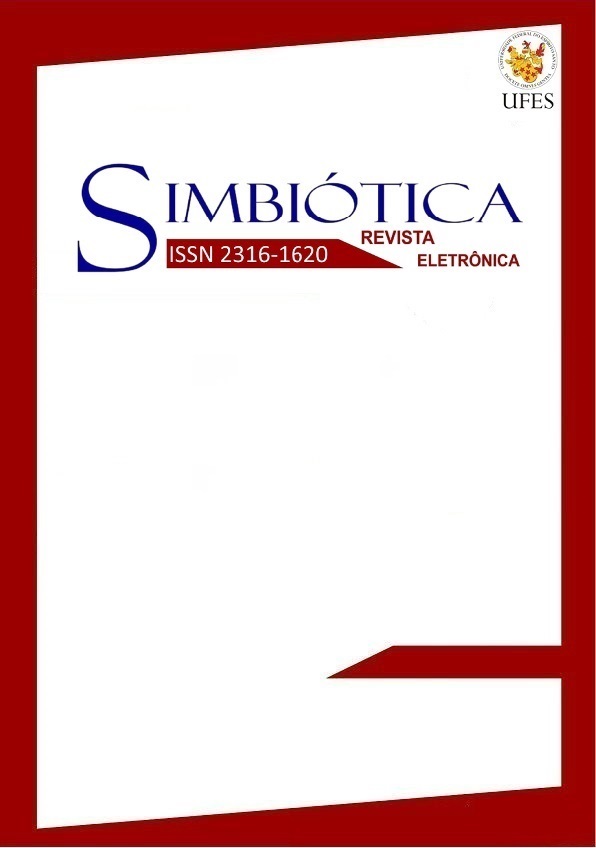Revolta e constituição: o parto sangrento em Gangues de Nova York
DOI:
https://doi.org/10.47456/simbitica.v4i1.19458Resumo
Resumo: O artigo é composto pela análise histórica do filme Gangs of New York, tratando tanto do período no qual o longa se passa, o século XIX, como do século XXI, momento em que o diretor Martin Scorsese o produz. Dessa forma, será estudada a representação do momento em que os Estados Unidos se encontravam em sua fase de consolidação como país, o papel dos imigrantes anglo-saxões na formação desse Estado, assim como a representação fílmica dos conflitos gerados pela presença dos mesmos. Por outro lado, também serão abordados o contexto histórico e o cenário geopolítico do início do presente século, e suas influências sobre as escolhas do diretor.
Palavras-chave: Guanges de Nova Yorque; século XIX; história; representação.
Resumen: El artículo consiste en el análisis histórico de la película Gangs of New York, tratando tanto del período en el que se establece la película, el siglo XIX, tanto como el siglo XXI, momento en el que el director Martin Scorsese produce. Por lo tanto, se estudiará la representación del momento en que Estados Unidos se encontraba en una fase de consolidación como país, el papel de los inmigrantes anglosajones en la formación de dicho Estado, así como la representación fílmica de los conflictos generados por la presencia de los mismos. Por otro lado, también se abordará el contexto histórico y la escena geopolítica de principios de este siglo, y su influencia en las opciones del director.
Palabras clave: Gangs of New York; siglo XXI; historia; representación.
Abstract: The article consists of the historical analysis of the film Gangs of New York, treating both the period in which the film is set, the nineteenth century, as well as the twenty-first century, at which director Martin Scorsese produces. Thus the representation of the time when the United States was in a consolidation phase as the country will be studied, so will be the role of Anglo-Saxon immigrants in the formation of that State, as well as the filmic representation of conflicts generated by the their presence. On the other hand, the historical context and the geopolitical scene of the beginning of this century, and their influence on the director's choices, will also be addressed.
Keywords: Gangs of New York; nineteenth century; history; representation.
Downloads
Referências
CAPELATO, Maria H. R. et. alli (Orgs) (2007). História e Cinema, ed. Alameda.
GREENE, Jack P. (2008). “Identidades dos estados e identidade nacional à época da Revolução Americana”. In: PAMPLONA, Marco A. e DOYLE, Don H. Nacionalismo no Novo Mundo: a formação de Estados-Nação no século XIX. Rio de Janeiro: Record.
HANBURY, Harry (2002). Uncovering the Real Gangs of New York. Parrhesia Pictures.
HARRIS, Leslie M. (2002). “In the Shadow of Slavery – African American in New York City, 1626-1863”. The University of Chicago Press. pp. 279-288.
HARRIS, Leslie M. (2015). “The New York City Draft Riots of 1863”. In: In the Shadow of Slavery: African Americans in New York City, 1626-1863. Último acesso em: 17/09/15. Disponível em: http://www.press.uchicago.edu/Misc/Chicago/317749.html
HUNTINGTON, Samuel P. (2004). Who are we? The challenges to america’s national identity. Simon & Schuster.
KENNEDY, Robert C. (2015) How to escape the draft. Acesso em: 17/09/15. Disponível em: http://www.nytimes.com/learning/general/onthisday/harp/0801.html#explanation
LIU, David (2011). “Of Time and the City”. The Daily Californian. Set.2011. Último acesso em: 23/11/15. Disponível em: http://www.dailycal.org/2011/09/08/of-time-and-the-city/
PECEQUILO, Cristina S. (2005). A política externa dos Estados Unidos: Continuidade ou mudança? Porto Alegre: Editora da UFRGS.
RÉMOND, René (1989). História dos Estados Unidos. São Paulo: Martins Fontes.
ROSENSTONE, Robert A. (2010). A história nos filmes, os filmes na história. São Paulo: Paz e Terra.
SCORSESE, Martin C. (2002). Gangs of New York. Miramax Film Corp.
WILLIAMS, Alex. Are we ever going to make this Picture? Último acesso em: 17/09/15. Disponível em: http://www.theguardian.com/culture/2003/jan/03/artsfeatures.martinscorsese
Downloads
Publicado
Como Citar
Edição
Seção
Licença
Copyright (c) 2020 Arthur Rodrigues Carvalho

Este trabalho está licenciado sob uma licença Creative Commons Attribution-NonCommercial-NoDerivatives 4.0 International License.
Autores que publicam nesta revista concordam com os seguintes termos:
a. Autores mantém os direitos autorais e concedem à revista o direito de primeira publicação, com o trabalho simultaneamente licenciado sob a Creative Commons - Atribuição-NãoComercial 4.0 Internacional.
b. Compartilhar - copiar e distribuir o material em qualquer meio ou formato.
Adaptar - remix, transformar e construir sobre o material para qualquer finalidade, inclusive comercial.
c. Autores têm autorização para assumir contratos adicionais separadamente, para distribuição não-exclusiva da versão do trabalho publicada nesta revista (ex.: publicar em repositório institucional ou como capítulo de livro), com reconhecimento de autoria e publicação inicial nesta revista.
d. Autores têm permissão e são estimulados a publicar e distribuir seu trabalho online (ex.: em repositórios institucionais ou na sua página pessoal) a qualquer ponto antes ou durante o processo editorial, já que isso pode gerar alterações produtivas, bem como aumentar o impacto e a citação do trabalho publicado (Veja O Efeito do Acesso Livre).
Authors who publish in this journal agree to the following terms:
a. Authors retain the copyright and grant the magazine the right of first publication, with work simultaneously licensed under the CCreative Commons - Atribuição-NãoComercial 4.0 Internacional.
b. Share - copy and distribute the material in any medium or format.
Adapt - remix, transform and build on the material for any purpose, including commercial.
c. Authors are authorized to take additional contracts separately, for non-exclusive distribution of the version of the work published in this journal (eg, publish in institutional repository or as a book chapter), with acknowledgment of authorship and initial publication in this journal.
d. Authors are allowed and encouraged to publish and distribute their work online (eg.: in institutional repositories or on their personal page) at any point before or during the editorial process, as this can generate productive changes as well as increase the impact and the citation of the published work (See The Effect of Free Access).














